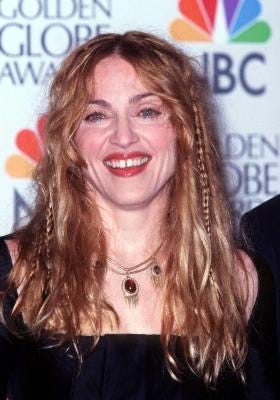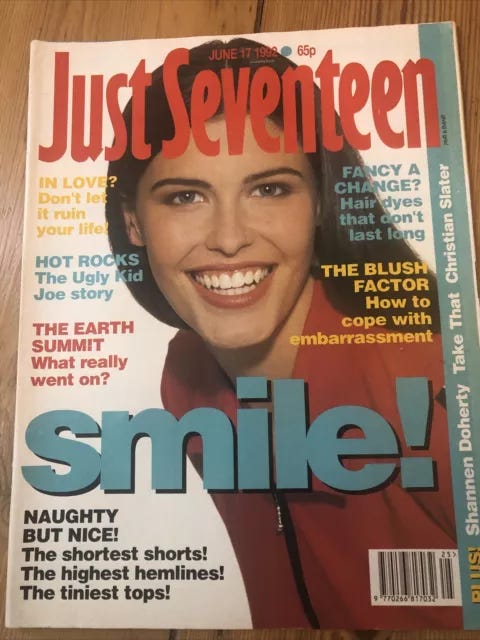What we see when we look at ourselves
A deep dive into into why I have always preferred being behind the camera and why I am trying to change that
Happy Wednesday!
This post came out of nowhere, or it felt like that way.
Friday’s are my main day for writing this newsletter and so last week my original intention had been to work on a different piece that I have playing around with for a while.
So that didn’t happen. And instead, I started this. Then, I found that I had lots to say about the area.
While I cannot put my finger on one thing that inspired this, what I can say is that it is perhaps one of my most personal pieces of writing. And it also one of the more random! I never said that I wanted a niche here, so I hope that you enjoy it and please let me know your thoughts in the comments.
Also, this post is going to be split into two parts and my aim is to share the second part with you next week. That’s the plan, anyway!
Thanks,
Sarah
What do you notice about this picture?
Yup, it’s Madonna. It’s also Madonna during her spiritual phase in 1998 in the same year she released her album: ‘Ray of Light’1.
You might have noticed how happy Madonna looks, the framing of the blonde hair and plaits around her face, or perhaps you were drawn to the ruby and gold necklace around her neck.
Ok, next one: What do you notice about this image?
This is Jürgen Klopp, ex-Liverpool football manager who is now head of soccer at Red Bull. Here he is advertising the travel company, Trivago.
Like Madonna, Klopp looks pretty happy, too. And who wouldn’t be when he’s probably been paid lots of money to star in a travel advert? As a general rule, I don’t spend too much time wondering what rich and famous people spend their money on. Yet I am curious how much Klopp paid for that glowing set of gnashers because I nearly fell off the back of my chair when I was confronted with them. The way that he’s leaning forward makes me think that he wants to bite the man opposite him. Or me.
I am not here to judge BUT his teeth are enormous, and quite obviously fake. Yet when I saw the advert on TV, I was reminded of seemingly ‘imperfect’ teeth like Madonna’s, and also those of the British actress, Aimee Lou Wood.
While Klopp has decided to adopt giant, perfect white teeth, Madonna and Wood haven’t. Madonna has described her teeth as “ugly” and has occasionally chosen to wear grills at events, while Wood has said that she has no intention of changing hers. She is quoted as saying that she feels “rebellious” for not having the teeth like many of her fellow (mostly American) actors.
How I wish that there had been more people like Wood saying stuff like this when I had been growing up!
You might be wondering about where I am going with all of this, so far it’s been all about celebrities and teeth? And you would be right, but this post is more than this because it’s about how we see ourselves both when we look in the mirror but also through the eyes of other people.
Mind the Gap!
In a rare moment when I can compare myself with Madonna, I grew up with a gap between my two front teeth. And you might be amused to learn that I used to try and fit a £1 coin in there. It didn’t, but a penny nearly did.
Perhaps the gap alone probably wouldn’t have bothered me too much, but my adult teeth also grew in chipped. I quite literally looked like I had been a bar fight, which was not the look I was going for as a teenager. When my then-dentist asked if I had fallen over and hit my mouth because he had never seen anything like it, I cried.
And as if I didn’t have enough insecurities about my appearance and life generally as a teenager, now it felt that my dentist confirmed what I saw when I looked in the mirror: ugly.
I was about 14 when the same dentist said that I could get a dental retainer that would ‘fix’ the gap, and then I could have fillings to cover the chipped parts. And at that point, I felt desperate.
My levels of self-consciousness about my teeth had risen to such dizzying levels that I was intensely preoccupied with my appearance. This manifested in several ways, such as often using my hand to hide my mouth when I was talking, but I especially hated being photographed. While there are family images of me or those taken with friends from this time, you are more likely to find me lingering in the back or turning my face away.
Of course, my unconventional teeth were not the only aspect of my physical self that I focused upon as a teenager, but they became a symbol for something else — I felt that because my natural teeth had grown in such a way that I was not just ugly on the outside, but also on the inside. They affirmed that I was somehow an unworthy person. But I could become worthy as long as I had my teeth fixed. Strange how the brain works.
What’s even stranger was that this idea was inadvertently confirmed when once my teeth had been fixed, I started dating my first boyfriend (by this point, I was 16). Clearly, he wouldn’t have been interested in me unless I had changed my appearance, right?
Teenage Dreams
By now, it feels appropriate to draw attention to a few things:
I am a white, female and grew up in a middle-class household in the UK
A large proportion of whatever I had left from my pocket money/pay from my paper round each month was spent on buying magazines aimed at young women such as myself
It goes without saying that diversity in terms of body shape and ethnicity practically didn’t exist in the lexicon of 1990s magazine publishing. So many of the models in these magazines would have been white like myself (And you could argue that not enough has changed in the industry 30 years on).
Also, if you are curious about which magazines I bought, my purchasing habits generally consisted of things like Bliss, Cosmopolitan, and my favourite, Just Seventeen (before it became Seventeen/J-17). Oh, and throw in the odd Smash Hits.
I did enjoy these magazines, or at least I think that I did. Reading them felt like I had access to a special window where I could find models, both literally and figuratively, that could show me how I was meant to present myself to the world.
And these models were exceptionally helpful in their own way. If I could just look like the women in these magazines, then surely, everything else would slot into place: I would have more confidence; I would be more popular; boys would like me and so on. In a practical sense, this consisted of trying to dress like the actual models despite my limited budget (although my parents would not have let me out of the house wearing: The shortest shorts! The highest hemlines! The tiniest tops!), as well as begging, usually with little success, for my mum to buy me the latest hair and skin products from the supermarket.
As I said earlier, once I had my teeth fixed, I assumed that life would be a bed of roses. And then, I waited.
Did I feel different? Was I bursting with confidence and more popular at school? Were boys more interested in me?
Heck, no!
The boyfriend that I mentioned came on the scene some months after the fixing of the teeth. And by that point, I may have had a new and improved smile, but that sense of feeling unworthy had become so deeply engrained in my psyche that I just focused my attention on other areas. Plus, I still hated having my photo taken.
And there’s the rub. I was the exact same person with the exact same insecurities, only now, I couldn’t blame my teeth/smile.
Part 2 - Coming Soon
Thanks for reading!
Sarah
Hi, I’m Sarah! The Best of Intentions is an independent publication about life in Hong Kong, travel, work, culture, health/fitness, photography, along with a sprinkle of psychology. If you like this post, consider liking or sharing it. If you are a regular reader please consider subscribing to receive updates and support my writing.
Still my favourite Madonna album.








I wore braces as a tween, then a retainer for a year. My teeth shifted a bit afterward, but only to the degree that an orthodontist would notice. At a recent cleaning appointment, the hygienist commented on my slightly imperfect bite and suggested I look into orthodontic work. I made it VERY clear that I would not, that I was happy with my smile, and that moving my teeth a few inches to perfect my alignment was nowhere close to worth wearing orthodontia AGAIN, as an adult. It was a moment when I realized how warped these standards are—and how do they affect our trust in dentists?
My colleague and I have been talking about teeth a lot lately. He just got braces (how old is Liam? 20s? yeah, let's go with that. he's young, but adult). We both have had them twice. For me, once as a teen and again in my 30s. Since we both hated wearing our retainers, his have moved back, and so have mine, but I've given up.
Funnily, I never saw anything wrong with his teeth. They're pretty damn white and straight, but some things bothered him, so now I can call him 'metal mouth'. Our obsession with super white Chicklets are rather insane, but there you have it, we're on perfection overload.
I, too, obsessed over woman's/teen magazines, so I get that feeling, especially as a teen. But, damn, if I'm not sooo grateful not to be a teen in the age of Instagram. Looking forward to part 2, Sarah!